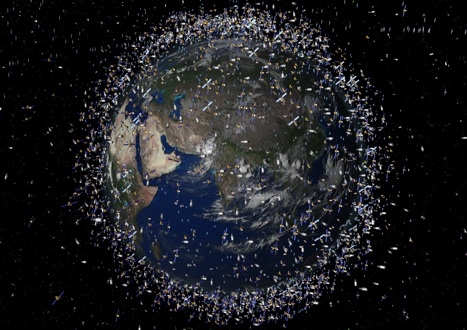
Designed, built and manufactured by a consortium including Airbus, ArianeGroup and Airbus-subsidiary Surrey Satellite Technology (SSTL) the so-called RemoveDEBRIS satellite, used a specially developed net to capture a deployed target simulating a piece of space debris.
A video of the test taken by the satellite (below) shows the net being fired at, and successfully smothering, the simulated debris, which is tumbling through space around 10 metres away from the spacecraft. During the trials, the net is detached from the satellite. However, the ultimate vision is that it would remain attached so that the satellite could drag the waste out of orbit.
The device was deployed from the International Space Station (ISS), having launched aboard the SpaceX Dragon spacecraft in April 2018.
As previously reported by The Engineer, space debris is a growing problem, with an estimated 7,600 tonnes of ‘space junk’ orbiting the Earth and posing a risk to satellites and other spacecraft. RemoveDEBRIS is one of a number of efforts worldwide to develop technology to address this problem.
Commenting on this initial trial Professor Guglielmo Aglietti, Director of the Surrey Space Centre, said: “We are absolutely delighted with the outcome of the net technology. While it might sound like a simple idea, the complexity of using a net in space to capture a piece of debris took many years of planning, engineering and coordination between the Surrey Space Centre, Airbus and our partners – but there is more work to be done. These are very exciting times for us all.”
Ingo Retat, Airbus RemoveDEBRIS project head, said: “To develop this net technology to capture space debris we spent 6 years testing in parabolic flights, in special drop towers and also thermal vacuum chambers. Our small team of engineers and technicians have done an amazing job moving us one step closer to clearing up low Earth orbit.”
The broader aim of the mission if to trial a range of different active debris removal technologies on mock target in low earth orbit. In the coming months, RemoveDEBRIS will test more so-called active debris removal (ADR) technologies including a vision-based navigation system that uses cameras and LiDaR technology to analyse and observe potential pieces of debris; the first harpoon capture technology used in orbit; and a drag-sail that will bring the spacecraft out of orbit and into the Earth’s atmosphere where it will be destroyed.
https://www.youtube.com/watch?reload=9&time_continue=9&v=_QUhCLTfXf0





Labour pledge to tackle four key barriers in UK energy transition
I'm all for clarity and would welcome anyone who can enlighten me about what Labour's plans are for the size and scale of this Great British Energy....